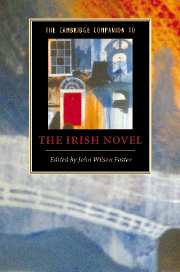Book contents
- Frontmatter
- Introduction
- 1 The novel before 1800
- 2 The national tale and allied genres, 1770s-1840s
- 3 The novel of the big house
- 4 The Gothic novel
- 5 Catholics and fiction during the Union, 1801-1922
- 6 Irish modernisms, 1880-1930
- 7 James Joyce
- 8 Region, realism and reaction, 1922-1972
- 9 The novel in Irish
- 10 Women novelists, 1930s-1960s
- 11 Two post-modern novelists: Samuel Beckett and Flann O’Brien
- 12 Life writing in the twentieth century
- 13 The novel and the Northern Troubles
- 14 Contemporary Irish fiction
- Index
11 - Two post-modern novelists: Samuel Beckett and Flann O’Brien
Published online by Cambridge University Press: 28 January 2007
- Frontmatter
- Introduction
- 1 The novel before 1800
- 2 The national tale and allied genres, 1770s-1840s
- 3 The novel of the big house
- 4 The Gothic novel
- 5 Catholics and fiction during the Union, 1801-1922
- 6 Irish modernisms, 1880-1930
- 7 James Joyce
- 8 Region, realism and reaction, 1922-1972
- 9 The novel in Irish
- 10 Women novelists, 1930s-1960s
- 11 Two post-modern novelists: Samuel Beckett and Flann O’Brien
- 12 Life writing in the twentieth century
- 13 The novel and the Northern Troubles
- 14 Contemporary Irish fiction
- Index
Summary
Beckett and story
The English writer E. M. Forster admitted of the novel as a form: 'Yes - oh dear yes-the novel tells a story.' It is difficult to imagine many Irish novelists so regretting story as the basis of their craft. Indeed, the novelist and playwright Thomas Kilroy has perceptively observed that that chromosome of story, the anecdote, is in the DNA of the Irish fictional tradition from at least the end of the eighteenth century. He advises, with reference to Maria Edgeworth’s Castle Rackrent (1800):
The distinctive characteristic of our ‘first’ novel, that which makes it what it is, is not so much its idea, revolutionary as that may be, as its imitation of the speaking voice engaged in the telling of a tale. The model will be exemplary for the reader who has read widely in Irish fiction: it is a voice heard over and over again, whatever its accent, a voice with a supreme confidence in its own histrionics, one that shares with its audience a shared ownership of the told tale and all that it implies: a taste for anecdote, an unshakeable belief in the value of human action, a belief that life may be adequately encapsulated into stories that require no reference, no qualifications beyond their own selves.
- Type
- Chapter
- Information
- The Cambridge Companion to the Irish Novel , pp. 205 - 222Publisher: Cambridge University PressPrint publication year: 2006

